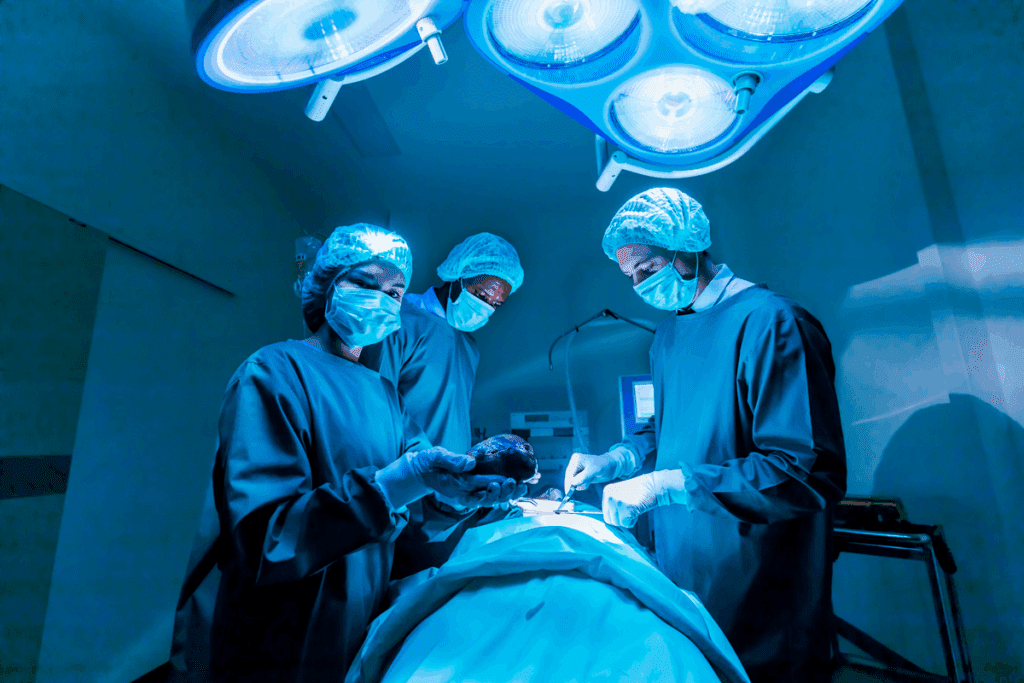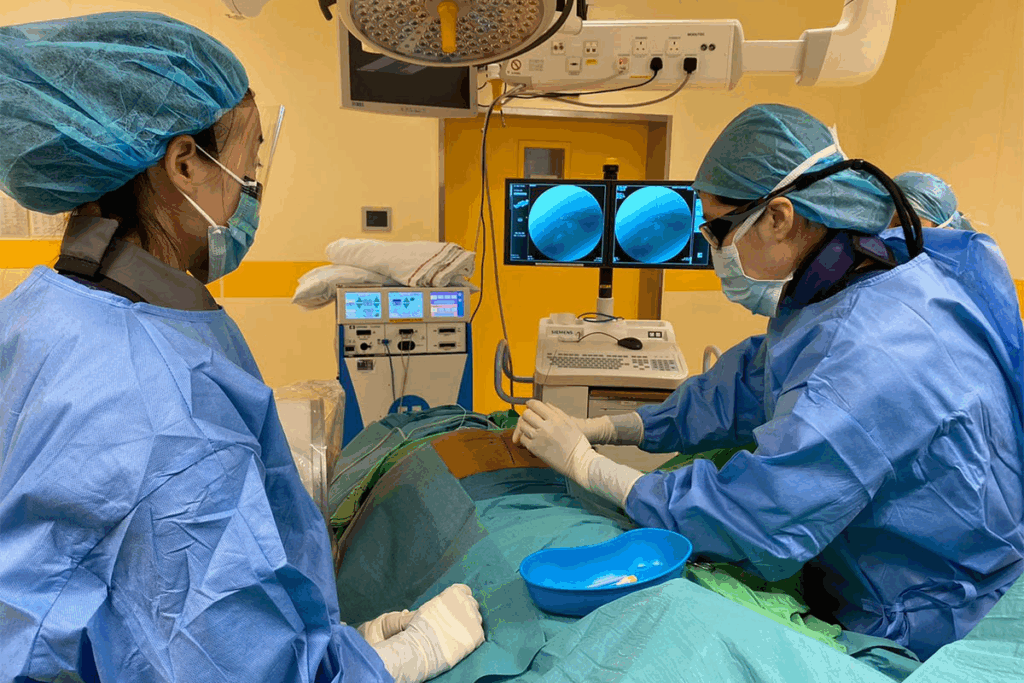Last Updated on October 31, 2025 by Bilal Hasdemir
Many people live without a bladder due to medical conditions. Thanks to better surgery and care, their lives have improved a lot. Knowing about ileal conduit, neobladder, or continent urinary reservoir is key.
Can you live without a urinary bladder? Learn about the high quality of life achievable after removal surgery (cystectomy) and urinary diversion.
These options help manage life after bladder removal. By learning about them and making lifestyle changes, people can take back control and live well.

It’s important for patients to know about bladder removal surgery. This surgery, also called cystectomy, is done for serious health reasons. It’s a big step in medical treatment.
Cystectomy is a surgery to remove the bladder. It’s often needed for bladder cancer, severe bladder problems, or other serious issues. The main goal is to take out the sick bladder and fix the health problem.
A study in the Journal of Urology says cystectomy is a key treatment for bladder cancer. It shows a big impact on patient health.
There are two main types of cystectomy: partial and radical. Partial cystectomy removes just the sick part of the bladder, while radical cystectomy takes out the whole bladder. The choice depends on the condition’s extent and type.
Procedure | Description | Indications |
Partial Cystectomy | Removal of the diseased portion of the bladder | Localized bladder cancer, certain benign conditions |
Radical Cystectomy | Removal of the entire bladder | Advanced bladder cancer, severe bladder dysfunction |
Patients with severe bladder issues might need this surgery. This includes bladder cancer, neurogenic bladder, or serious bladder damage. The choice to have cystectomy depends on the patient’s health and the disease’s severity.
“The decision to perform a cystectomy is complex and involves careful consideration of the patient’s medical history, the extent of their disease, and their overall health status.”
Knowing about bladder removal surgery helps patients understand their options. This way, they can make better choices for their care.

Bladder removal surgery is chosen when certain health issues affect the bladder’s function. This surgery, known as cystectomy, is considered when other treatments fail or are not possible.
Bladder cancer is a common reason for bladder removal surgery. If cancer is found in the bladder, surgery to remove it is often needed. Early detection and treatment are key to managing bladder cancer well.
Neurogenic bladder happens when brain, spinal cord, or nerve problems affect bladder control. This can lead to serious issues like chronic infections or kidney damage. Managing neurogenic bladder often requires a team effort.
Severe bladder injuries, often from accidents or injuries, may require bladder removal. The decision to remove the bladder depends on the injury’s severity and the patient’s health.
Other conditions that might need bladder removal include interstitial cystitis, bladder fistulas, and certain birth defects. Each condition has its own challenges and needs careful thought about treatment.
Condition | Description | Potential Treatment |
Bladder Cancer | Cancerous cells in the bladder | Cystectomy, Chemotherapy |
Neurogenic Bladder Dysfunction | Bladder control issues due to nerve damage | Bladder removal, Catheterization |
Severe Bladder Trauma | Extensive damage to the bladder | Surgical repair, Bladder removal |
Knowing about these conditions and their treatments helps patients and doctors make better choices for bladder health.
Can You Live Without a Urinary Bladder? The Simple Answer
Living without a bladder is tough but doable. The right medical care and lifestyle changes help people stay active.
Adjusting to life without a bladder means learning about urinary diversion options. It also means making lifestyle changes. Following doctor’s advice and keeping up with follow-ups helps manage the effects of bladder removal.
After a cystectomy, patients have several options for managing their urinary diversion. The choice of diversion depends on various factors, including overall health and personal preferences.
The ileal conduit is a common method used to divert urine. It involves using a portion of the intestine to create a conduit for urine to exit the body.
A continent urinary reservoir is another option, which allows for more normal urination. This method involves creating a pouch to store urine.
Neobladder reconstruction is a complex surgical procedure. It involves creating a new bladder from a segment of intestine.
Each of these options has its benefits and drawbacks. The choice depends on individual patient needs and preferences.

Choosing to have bladder removal surgery starts a journey. It includes getting ready, the surgery, and care after. Knowing what to expect can ease worries and prepare you.
Before surgery, patients go through many checks. These ensure they’re ready for the procedure. This includes:
They also get advice on what to do before surgery. This includes changing diets, stopping some medicines, and making plans for aftercare at home.
Bladder removal surgery, or cystectomy, is done under general anesthesia. The team makes cuts to reach the bladder. They then carefully remove it from the body.
After surgery, patients are watched closely in a recovery room. Managing pain is key, with medicine given as needed. They also check for any complications like infection or bleeding.
The time in the hospital varies. It depends on the surgery type and the patient’s health. Less invasive surgeries usually mean shorter stays than open surgeries.
Type of Cystectomy | Average Hospital Stay |
Minimally Invasive | 3-5 days |
Open Cystectomy | 5-7 days or more |
Knowing about the surgery and hospital stay can help reduce anxiety. Being informed helps patients prepare for their journey.
Recovering at home after bladder removal surgery is a big task. You need to take care of your body and mind. Managing your urinary diversion is key to a smooth recovery.
It’s also vital to eat well and see your doctor regularly. Knowing what to expect and having support can help a lot. This way, you can get through this tough time and do well.
Managing complications after bladder removal surgery is key to a good quality of life. This surgery can save lives but comes with risks. It’s important to address these issues quickly.
Patients may face several physical issues after surgery. These can include:
It’s essential for patients to be aware of these complications to ensure timely intervention.
Preventing infection is a key part of post-operative care. We advise patients to follow a strict hygiene regimen, including:
Early detection of infection can significantly improve outcomes.
Patients should watch their health closely and contact their doctor if they notice:
Regular follow-up appointments with healthcare providers are vital for managing these risks effectively.
Long-term health monitoring is essential after bladder removal surgery. Regular check-ups help in:
By maintaining regular follow-up appointments, patients can significantly reduce the risk of long-term complications.
After a cystectomy, people must change their lifestyle. They need to focus on caring for their urinary diversion. This means following a daily routine, making diet changes, and adjusting physical activities.
Keeping the stoma site clean is key. A balanced diet is also important. Gentle exercises, like yoga or short walks, can boost health.
Adjusting to life without a bladder takes time and effort. But with patience and flexibility, people can live active and meaningful lives.
Bladder removal surgery is a big deal that needs a lot of thought and planning. Knowing your options and the possible hurdles helps a lot. With the right attitude and support, you can really make the most of life after surgery.
Yes, it is possible to live without a bladder. After a cystectomy, the body adapts by using alternative methods for urine storage and elimination.
There are several options, including ileal conduit, continent urinary reservoir, and neobladder reconstruction.
Managing life without a bladder requires adapting to a new urinary diversion system, such as using a urostomy bag or learning to catheterize. It’s essential to follow a healthcare provider’s guidance and attend follow-up appointments.
As with any surgery, there are possible complications, like infection, leakage, or bowel obstruction. But, with proper care and follow-up, many people recover well and lead active lives.
Yes, many people are able to lead active and fulfilling lives after bladder removal surgery. With the right medical care and support, individuals can adapt to changes and manage their condition effectively.
Recovery time varies depending on individual factors, but most people can expect to spend several weeks to a few months recovering.
Some lifestyle adjustments may be necessary, such as changes to diet, exercise, or daily routines. But, with proper guidance and support, many people are able to adapt and maintain a good quality of life.
Yes, many people are able to resume physical activities, such as exercise or sports, after recovering from bladder removal surgery. But, it’s essential to follow the guidance of a healthcare provider to ensure a safe and healthy return to activity.
National Center for Biotechnology Information – Can You Live Without a Urinary Bladder Life. https://pmc.ncbi.nlm.nih.gov/articles/PMC6909864/
Subscribe to our e-newsletter to stay informed about the latest innovations in the world of health and exclusive offers!
WhatsApp us